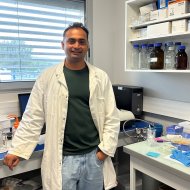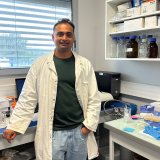Interviews

Rafaela
Zani Coeti
Institution Saarland University Position Postdoctoral Research Assistant
You joined the Saarland University recently to work in the SINPAIN project. What’s your scientific background? I am a Brazilian biologist, with a PhD in Science. My scientific career began during my university education, when I did an internship in a histology lab. I enjoyed it so much that I became a teaching assistant in the histology classes. After my graduation as a biologist, I moved to a larger city (São Paulo, Brazil, the sixth largest city in the world) where I completed both my master's and doctoral degrees, always working with histology and animal models.
What made you go into science? Why did you choose this topic? When I was very young (10 years old), I saw a documentary about snakes. I was so amazed at how these animals could move without legs that I decided to become a biologist. I spent a long time working with histology and wildlife reproduction but after the COVID pandemic, I felt the need, as a biologist, to understand more and use my knowledge in the medical field. When I moved from Brazil to Germany, I had the opportunity to join the team at Saarland University and used my previous skills in the fantastic world of cartilage and osteoarthritis treatment.
What are you currently working on within the scope of SINPAIN? I joined the project with a very serious goal in mind: to test the treatments developed by researchers and partner institutes using a clinically relevant in vivo animal model of osteoarthritis. I feel like our results are the final piece of the puzzle that several researchers have been putting together for some time. It is a very important task and I want to do my best to participate in the outstanding SINPAIN project.
How do you see the field of RNA-based therapies for osteoarthritis evolving in the future? The field of RNA-based therapy is, in my view, most promising, not only for the treatment of osteoarthritis but also for other diseases and in the development of not only treatments, but also vaccines. Osteoarthritis is a multifactorial, highly prevalent disease without a cure to date, meaning that many variables are involved in its development. RNA-based therapies enable to target very specific genes, potentially preventing a large percentage of side effects. In the future, I hope this therapy can cover a greater number of genes and variables, bringing comfort to more patients worldwide.

Christopher
David
Institution University of Liverpool Position Postdoctoral research assistant
What are your specific tasks in the SINPAIN team at University of Liverpool? As part of the SINPAIN team at the University of Liverpool, I serve as the Deputy Team Leader for Work Package 2, which focuses on tackling immune responses. In this role, I support the coordination and strategic planning of our team’s objectives, while also contributing directly to the experimental work. My primary responsibility is to investigate how advanced therapeutics interact with the human immune system. This includes studying both local and systemic immune responses, with a particular emphasis on how immune cells react to these novel treatments. I carry out detailed immunological assessments, which help us understand therapeutic efficacy and potential immunogenicity. Ultimately, my work aims to ensure that the treatments we develop are both effective and immunologically safe.
What would you say are the specific challenges associated to your work? There are several, and they reflect some of the broader complexities in this area of research. One major challenge is working with advanced biomaterials that are still in the development stage. Their compositions can change over time, so we need to continuously adapt our immunological assessment protocols. Coordinating across a multidisciplinary team spread across Europe also brings logistical hurdles. It requires clear communication to ensure alignment, particularly when timelines and priorities shift. From a technical standpoint, having access to validated in vitro models and immune-relevant human cell lines is essential to ensure our findings are meaningful and translatable. When possible, we also rely on primary samples from healthy donors to increase physiological relevance. And of course, we’re dependent on a reliable supply of commercial reagents and assay kits to maintain reproducibility. Strong internal quality control and careful data management tie everything together, helping ensure that our results are robust and suitable for downstream application or publication.
What does it mean to you to be part of the SINPAIN project? Being part of the SINPAIN project is both exciting and deeply meaningful to me. It’s given me the chance to apply my background in nanotherapeutics, regenerative medicine, and immunology to a new and important area, osteoarthritis, which I hadn’t previously worked in. That fresh perspective has been both challenging and rewarding. What makes the experience especially fulfilling is the collaborative environment. I’m surrounded by a diverse group of partners across the consortium, each bringing their own expertise and insights. It’s a setting where I’m constantly learning, exchanging ideas, and contributing to something with real potential impact. The fact that our work could one day help improve the lives of people living with osteoarthritis makes it all the more motivating.
In your opinion, what impact does SINPAIN have? Rather than simply managing the symptoms of osteoarthritis, SINPAIN aims to alter the course of the disease itself by restoring damaged cartilage. Through the use of siRNA technology and sophisticated delivery systems, the project is paving the way for a new class of treatments that could preserve joint function and improve quality of life for patients living with chronic pain. It’s an exciting step toward more proactive and regenerative solutions in osteoarthritis care.

Alexander
Deneka
Institution UCLA Position Assistant Project Scientist
What is your role in the SINPAIN team at UCLA? As an Assistant Project Scientist at UCLA, my role within SINPAIN focuses on characterizing mesenchymal progenitor cells and perivascular stem cells in the context of osteoarthritis progression. Leveraging my expertise in cellular signaling pathways, flow cytometry, RNA sequencing, and immunohistochemistry, I aim to elucidate the regenerative potential of these cells and their applications in RNA-based therapies.
What are you currently working on within the scope of SINPAIN? My current work within SINPAIN involves studying the cellular and molecular characteristics of perivascular stem cells and their interactions in the osteoarthritic microenvironment. By employing advanced cell profiling techniques, I am investigating their role in osteoarthritis progression, particularly in the context of angiogenesis.
How do you see the field of RNA-based therapies for osteoarthritis evolving in the future? RNA-based therapies hold immense promise for osteoarthritis, particularly in targeting key inflammatory pathways and promoting tissue regeneration. With advancements in delivery systems and stability enhancements, I foresee a shift toward more precise and patient-specific treatments, ultimately leading to disease-modifying interventions rather than just symptom management.
Do you see a difference between Europe and the US? Both Europe and the US are advancing RNA-based therapies, but regulatory pathways and funding mechanisms differ significantly. The US benefits from a strong biotech ecosystem with venture capital backing, while Europe emphasizes large-scale, collaborative research efforts such as SINPAIN. These differing approaches create unique opportunities for innovation and translational research in both regions.

Joan
Cabellos
Institution Asphalion Position Scientific & Regulatory Affairs Senior Officer
What is your role at Asphalion and how is the company involved in SINPAIN? As a Scientific and Regulatory Senior Officer at Asphalion, I focus on scientific writing and regulatory support for medicinal products, including Advanced Therapy Medicinal Products (ATMPs) during their development until marketing authorisation. I am involved in various regulatory activities, such as preparing regulatory documents during development and communicating with authorities to ensure compliance with regulatory requirements.
In the SINPAIN project, Asphalion guides all partners to ensure compliance with regulatory requirements for developing nanotherapeutics from early stages. Through a roadmap, Asphalion has identified the applicable regulatory classification for SINPAIN products, which will be further validated in an EMA Innovation Task Force. This process will reinforce the regulatory strategy and lay a good foundation for the successful development of SINPAIN products to reach the market.
Regulatory aspects are important in research projects focusing on the development of new therapies. What is the most important aspect? In research projects focused on developing new complex borderline products like SINPAIN, a crucial regulatory aspect is obtaining comprehensive data to support the accurate classification of the product and in this way choose the correct regulatory guidelines for product development. Furthermore, even from early development, it is very important to generate robust manufacturing and preclinical data to elucidate the mechanisms of action and a medical plausibility, quality and safety as well as clinical efficacy at later stages. Robust data facilitates integrated progression through development stages and ultimately fulfils requirements for market approval.
And what do research partners tend to forget? Research partners often overlook the critical importance of thorough documentation and data validation in the rush to innovate. Ensuring meticulous record-keeping and validation processes is essential for achieving regulatory compliance and successful product classification. This process includes maintaining detailed logs of experimental procedures, results, and analyses and validating data through rigorous quality checks and, if needed, internal audits.
With your background, how do you see the field of RNA-based therapies evolve in the future? I see RNA-based therapies evolving significantly in the future. These therapies offer enormous potential for precise, targeted treatments, with innovations likely focusing on enhancing delivery systems and improving safety profiles. Existing siRNA therapies, like patisiran and givosiran, demonstrate the potential of these approaches. As these therapies integrate with existing strategies, they could revolutionize treatment standards, particularly in personalized medicine.

Line
Kawtharany
Institution INSERM Position Research Engineer
When you joined the INSERM team in SINPAIN the project was already running. How have you settled in and what are your tasks in the project? I joined the INSERM team as a research engineer at Biotis on June 1, 2023, about one year after the start of SINPAIN. I have settled in well and am currently working on evaluating axonal growth inhibition. Specifically, my tasks include testing the capacity of candidates to modulate sensory innervation (axonal growth and sprouting) and assessing the potential of nanoformulations (IL1β, NGF) on reducing axonal growth. I also analyze the crosstalk between sensory neurons and non-neuronal cells in the context of inflammation, focusing on sensory neurotransmitters like CGRP and SP.
Can you tell us a bit more about your background and previous experience and how SINPAIN benefits from it? I completed my Ph.D. in Biochemistry at the University Claude Bernard Lyon 1 in 2022, where I worked on an in-vivo project focused on micro calcifications in atherosclerotic plaques. While this was not directly related to osteoarthritis, my experience with complex biological processes and inflammation gives me valuable expertise that can be applied to the SINPAIN project. This multidisciplinary background helps me approach the challenges of developing innovative therapies for osteoarthritis from a broader scientific perspective.
Is this your first experience with an EU-funded project? What do you like about it? This is my second experience with an EU-funded project, as my Ph.D. was also part of a European project focused on atherosclerosis. What I particularly appreciate in these projects is the regular collaboration with experts from different fields and countries. These meetings are invaluable for gaining deeper insights into complex diseases like osteoarthritis, thanks to the diverse perspectives shared. Additionally, such projects often lead to high-quality scientific publications, which contribute significantly to advancing knowledge in these challenging fields.
In your opinion, what impact will SINPAIN have in the fast-developing field of new therapies for OA? The SINPAIN project has the potential to revolutionize osteoarthritis treatment by developing innovative, personalized therapies targeting both early and advanced stages of the disease. By combining advanced siRNA-based nanoformulations with a novel injectable viscosupplement, the project aims to address not only the symptoms but also the underlying biological mechanisms of osteoarthritis. Additionally, the use of ex vivo and in vivo models, along with a 3D biomechanical model, will help to better understand disease progression and optimize therapeutic strategies. This personalized approach could greatly enhance treatment efficacy and patient outcomes in osteoarthritis care, offering improved quality of life for patients suffering from this debilitating condition.

Davide
Raineri
Institution Università del Piemonte Orientale Position Research fellow
What is your research focus at Università degli Studi del Piemonte Orientale (UPO)? At present, I am involved in several national and international projects, employing cutting-edge single-cell technologies such as high-dimensional flow cytometry, single-cell RNA sequencing, and imaging mass cytometry. I use these technologies for my research on osteoarthritis, cancer, and autoimmune diseases such as rheumatoid arthritis and multiple sclerosis. My primary goal is to address how the immune system contributes to these conditions to identify potential therapeutic targets, ultimately aimed at improving patient outcomes.
What made you go into science? I developed an interest in science because when I performed my first experiment, I was captivated by the thrill of discovery. The excitement of finding something new and solving problems was unlike anything else, and that passion continues to drive my research today.
In your opinion, what are the major challenges that RNA based therapies are facing today? In my opinion, the major challenges that RNA-based therapies face today include efficient delivery to target cells, ensuring stability and avoiding degradation in the body, and minimizing off-target effects and immune reactions. Overcoming these hurdles is crucial for the successful development and widespread use of these therapies.
Is this your first experience working on an EU-funded project and are you working in other EU-projects at the moment? If yes, how would you describe their similarities/differences and is there any way in which they interact or complement one another? SINPAIN is my second experience with EU-funded projects. Indeed, I’m also involved in another European project (FLAMIN-GO https://flamingo-joc.eu/project/). These projects primarily engage my research group in using cutting-edge OMIC technologies to explore immune-physiopathology across different biological contexts. Scientifically, they differ significantly. However, what unites them is the collaborative bond formed with diverse partners. Beyond science, these collaborations foster relationships that extend far beyond the duration of individual projects, potentially leading to new project opportunities in the future.

Huan
Meng
Institution AO Research Institute Davos Position Postdoc researcher Field of Research Regenerative Orthopaedics
How long have you been with the AO Research Institute Davos (ARI) and what is your educational background?
I joined the AO Research Institute in Davos as a postdoc researcher in November 2022, half a year after the start of SINPAIN. Before that I had finished my PhD in Medical Engineering at Queen Mary University of London.
What are ARI’s tasks in the SINPAIN project?
The tasks of ARI in SINPAIN include: 1) the development and optimisation of in vitro 3D models of osteoarthritis, by mimicking the tissue composition of knee joints and the inflammatory and mechanical conditions of osteoarthritis; 2) the efficacy testing of novel nano-therapeutics using our 3D osteoarthritic model.
What motivates you personally in a collaborative project like SINPAIN?
The SINPAIN project fuels my enthusiasm through its collaborative approach towards innovating osteoarthritis treatment. I am impressed by the rich exchange of ideas among experts and young scientists in the project, each contributing unique skills and ideas towards a unified, effective therapy. This collaborative energy not only propels scientific advances but also fosters a culture of shared knowledge and mutual success.
In your opinion, what impact does SINPAIN have?
SINPAIN will have a significant impact on society and the scientific community. By advancing the development of an affordable, advanced combination therapy for knee osteoarthritis, the SINPAIN project has the potential to alleviate the pain of millions of patients, slow down and even reverse the progression, and reduce the socio-economic burden of osteoarthritis. Meanwhile, the project is setting a precedent for how multidisciplinary teams can tackle complex health challenges through innovation.

Dinesh
Dhumal
Institution OZ Biosciences Position Formulation Scientist
****
What are your specific tasks in the SINPAIN team at OZ Biosciences?
My specific task in the SINPAIN team at OZ Biosciences include (i) Screening of various ionizable lipids for siRNA delivery; (ii) Optimization of the final stable lipid nanoparticle (LNP)-siRNA formulations; and (iii) Functionalization of LNP-siRNA with targeting moieties for targeted siRNA delivery for the treatment of knee osteoarthritis.
What makes working in the SINPAIN project special for you?
The SINPAIN project gives me an excellent chance to work with a dynamic consortium. It gives an opportunity to apply my nanomedicine knowledge for the development of a valuable nucleic acid therapeutics that can be utilized in the future for the treatment of knee osteoarthritis (OA). In any event, it will generate and contribute significant useful research data and methodology for the scientific community.
How do you see the field of RNA-based therapies for osteoarthritis evolving in the future?
Approval of 2 mRNA based Covid vaccines and several other RNA-based therapies has given an unprecedented boost to the RNA-based therapy research and market in recent time. Current OA therapies such as non-steroidal anti-inflammatory drugs (NSAIDs) only give symptomatic relief but come with adverse effects because of long term uses. Non-pharmacological treatment arthroplasty is most effective at the end stage of OA, therefore RNA-based therapies which have the capability to treat the root cause of any disease shows promise in OA management by addressing the factors responsible for inflammation cartilage degeneration.
What kind of impact will SINPAIN have on your company? What are you expecting?
The SINPAIN platform gives us a strong networking opportunity in academic-industry (SME) research. SINPAIN is allowing us to explore OZ Biosciences’ 20 years of expertise in nanomedicine for the targeted delivery of RNA therapeutics for challenging diseases like OA which will definitely produce some exciting research outputs which could contribute in the development of new RNA-based therapies for current and future objectives at OZ Biosciences. We expect a strong academic-industry and industry- industry relationship for betterment of science and positive results as a contribution for the development of RNA based therapies for OA treatment and management.

Francesca
Angelone
Institution Reykjavik University Position Visiting PhD Student
What is your role in the SINPAIN team at Reykjavik University? My tasks in the SINPAIN team concern the analysis of medical images to extrapolate textural information from cartilage not visible to the naked eye, to allow an automatic characterization of the state of degeneration of cartilage tissue in patients suffering from osteoarthritis (OA).
What motivated you to choose your research subject? The choice of this research subject allows me to delve deeper into the topic of automatic analysis of medical images in a field of great scientific interest as OA is one of the main causes of disability for millions of people in the world. The hope is to contribute to providing useful tools to support clinicians' work to quickly recognize risk states and possible correlations with biological factors.
Is this your first experience working on an EU-funded project? What is your opinion about this programme? This is my first experience in an EU-funded project, and I am grateful to have the opportunity to work with a multidisciplinary team and open my horizons. This programme can represent a scientific hub and a moment of debate between actors with different backgrounds and offers the possibility of enriching oneself and contributing to the understanding of mechanisms underlying OA that are still not known today.
In your opinion, what impact does SINPAIN have? What is special about the project? The SINPAIN project offers the opportunity to combine different scientific knowledge for one great objective: to improve the living conditions of patients suffering from OA through innovative therapies and advanced diagnostic options, overcoming the limits of current medicine in considering pathology. Those who have chosen to devote themselves to medical research have the desire to ensure that their work can help people who are struggling with difficult health situations every day. The SINPAIN project allows you to team up to pursue this goal and that’s what makes it so special.

Beatriz
Ribeiro
Institution i3S Position Research Technician
What are your specific tasks in the SINPAIN team at i3S?
My tasks in the SINPAIN project involve the characterization of the human knee joint, through the collection and stratification of patients’ tissues. More specifically, we aim to further characterize the cell populations that drive the inflammation and pathological innervation of osteoarthritis (OA).
What are you currently working on within the scope of SINPAIN?
At the moment, we have been collecting human samples from hip and knee arthroplasties to stratify the patient tissues regarding gender, lesion grade, among others, and posterior cell characterization. This current task is possible due to a collaboration established between our team at i3S and the Orthopaedics Department of Centro Hospitalar Universitário São João, Porto, Portugal.
What makes working in the SINPAIN project special for you?
Working on SINPAIN gives me the opportunity to deepen my knowledge on the mechanisms behind OA progression, aiming to increase the life quality of people who suffer from the debilitating symptoms of this condition daily. Moreover, as it is an European project, it also widens my horizon to the importance of multidisciplinary collaborations in the scientific field.
In your opinion, what impact does SINPAIN have? What is special about the SINPAIN project?
OA is the most common chronic joint disorder and a substantial cause of disability in the elderly, affecting millions of people worldwide. So far, no effective therapies have been discovered for this condition, which implies that patients suffering from OA do not have a promising solution to attenuate or stop chronic pain and disease progression. The impact of the SINPAIN project relies on filling this gap in therapeutic options. By combining different scientific fields, this project allows for a deep study using human samples and testing diverse nanoformulations, taking an important and promising step towards a personalized medicine in the context of OA.
For more information about Beatriz, visit her LinkedIn profile.

Cristian
Salvador
Institution CIDETEC Position Junior Researcher
What are your specific tasks in the SINPAIN team at CIDETEC?
My tasks in the project are related to the development of non-viral vectors for siRNA delivery and range from the synthesis of biomaterials to efficacy tests using in vitro models.
What made you go into science?
When I was a child, I was always wondering why things happened and I was fascinated by understanding the processes of physiology and chemistry. Later, I discovered that these naturally occurring mechanisms could be harnessed to develop technology that could improve our way of life and reverse nature's failures.
What makes working in the SINPAIN project special for you?
It is a great opportunity to finetune the vectors specifically for the knee environment and explore their potential to reach different type of cells and their implementation in different therapies.
How do you see the field of RNA-based therapies for osteoarthritis evolving in the future?
I think that the field of RNA-based therapies holds significant promise for the treatment of genetic-based diseases such as osteoarthritis. If we are able to overcome the challenges, it could lead to a breakthrough in treating this condition. I believe that, as research in this field continues to evolve, we will continue to see exciting advancements and discoveries that will benefit patients and improve their quality of life.
What are your goals after SINPAIN? How does working in the team of an international research project contribute to reaching these goals?
Following my involvement with SINPAIN, I aim to further my work in RNA therapy development for various cell types and explore the potential application of vectors in other therapeutic areas. By collaborating with the interdisciplinary team in SINPAIN, comprising experts from every field involved in the disease, I can gain valuable insights and understanding of the biological implications of the biomaterials we synthesized. This experience will undoubtedly enhance my skills and knowledge, and contribute significantly towards my future goals.










